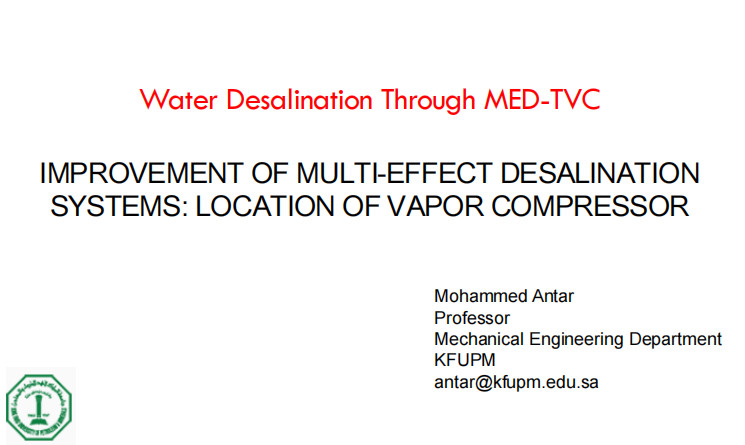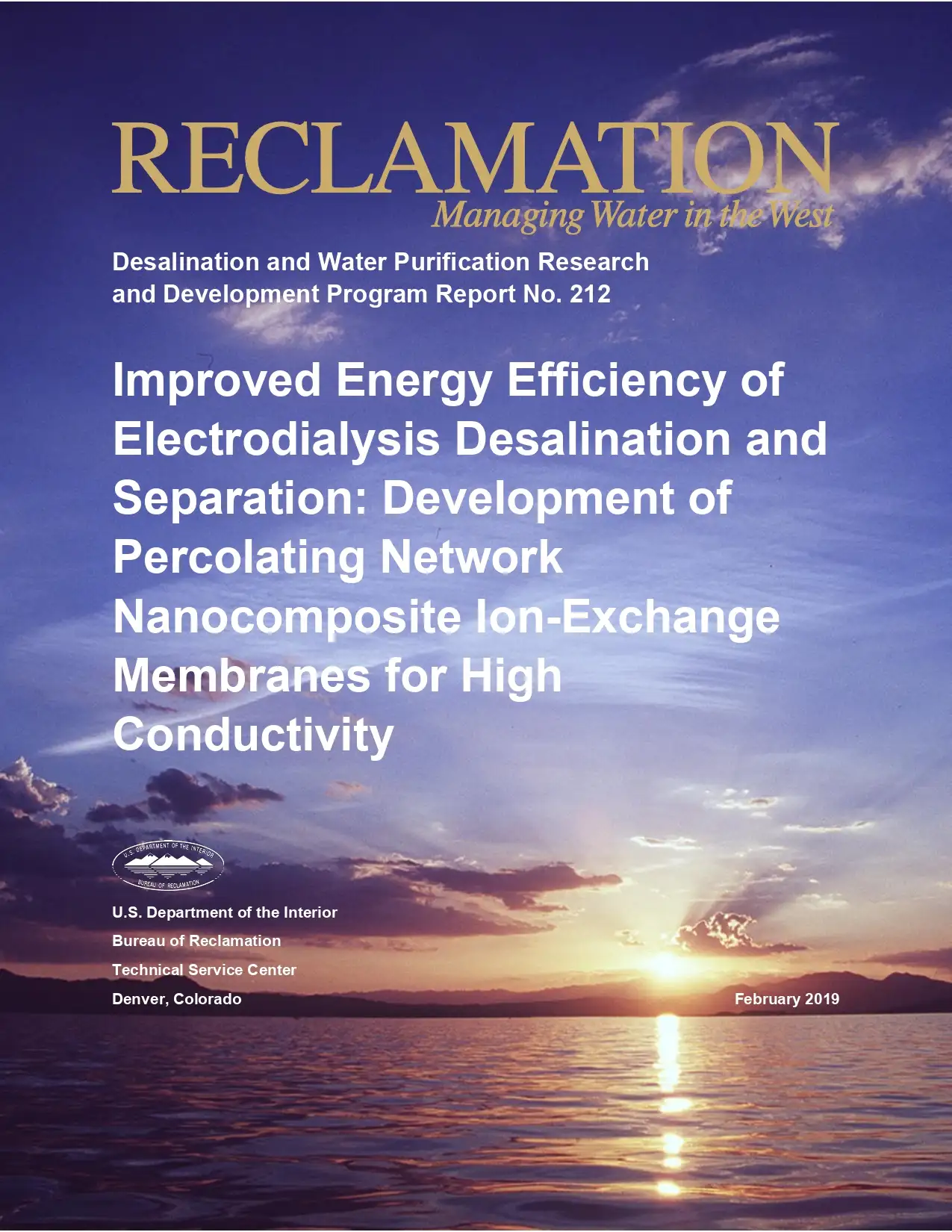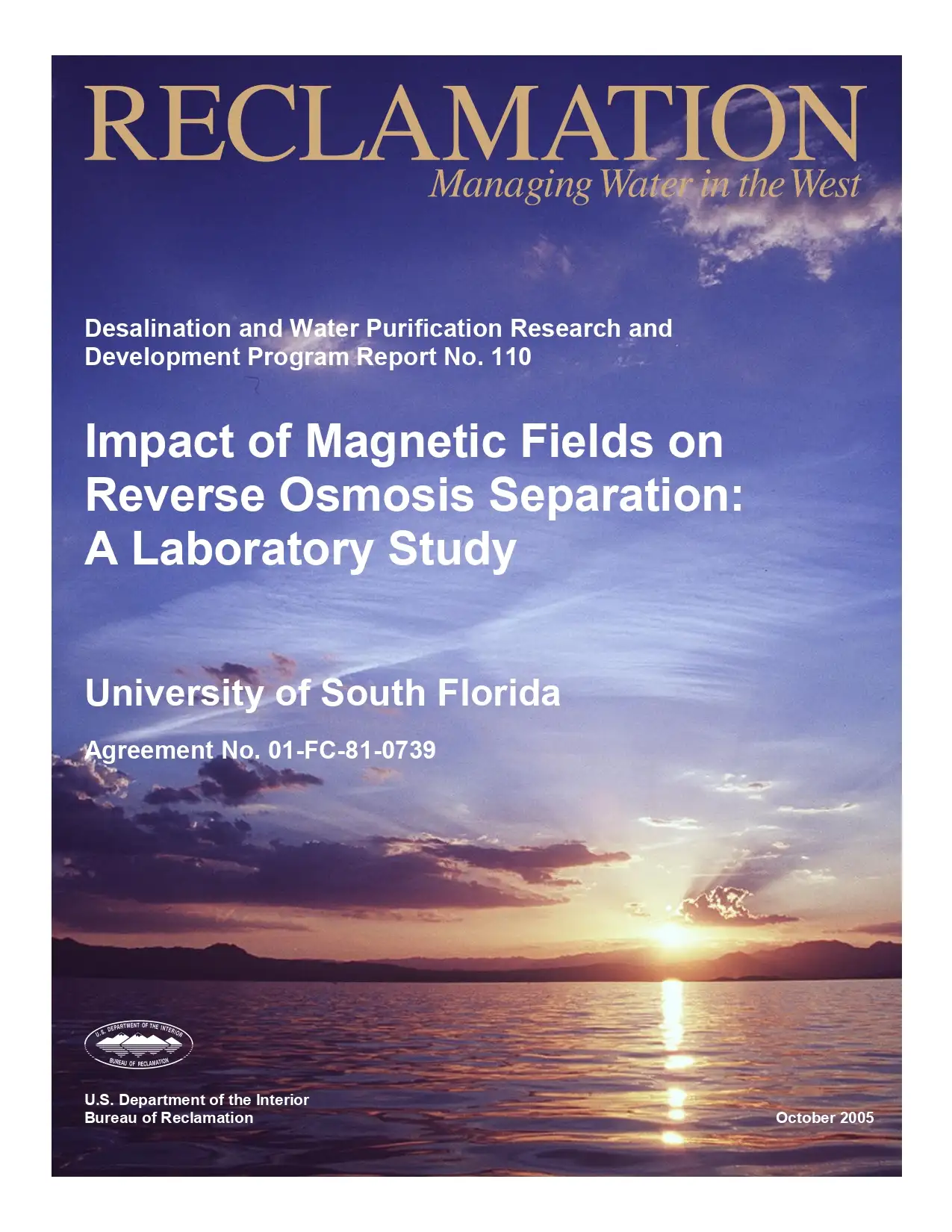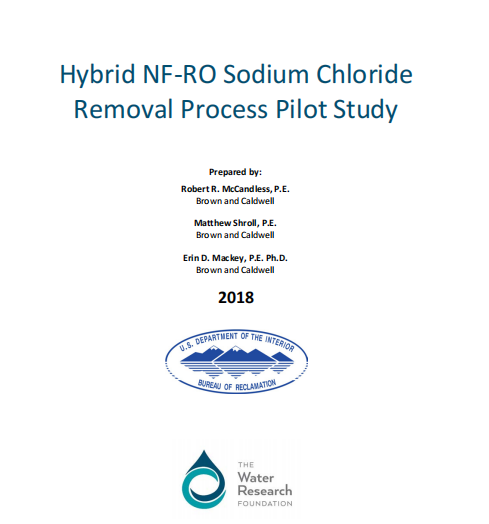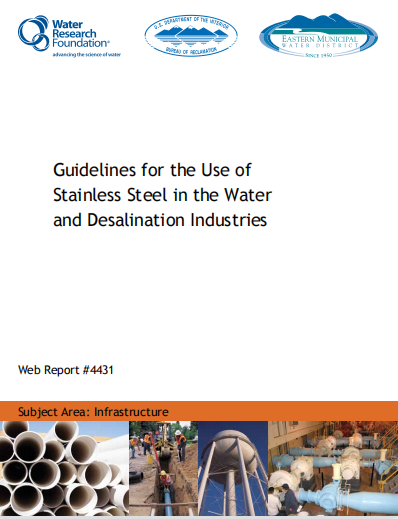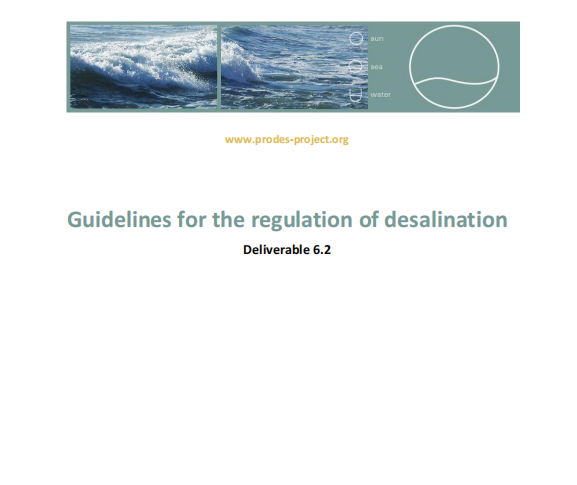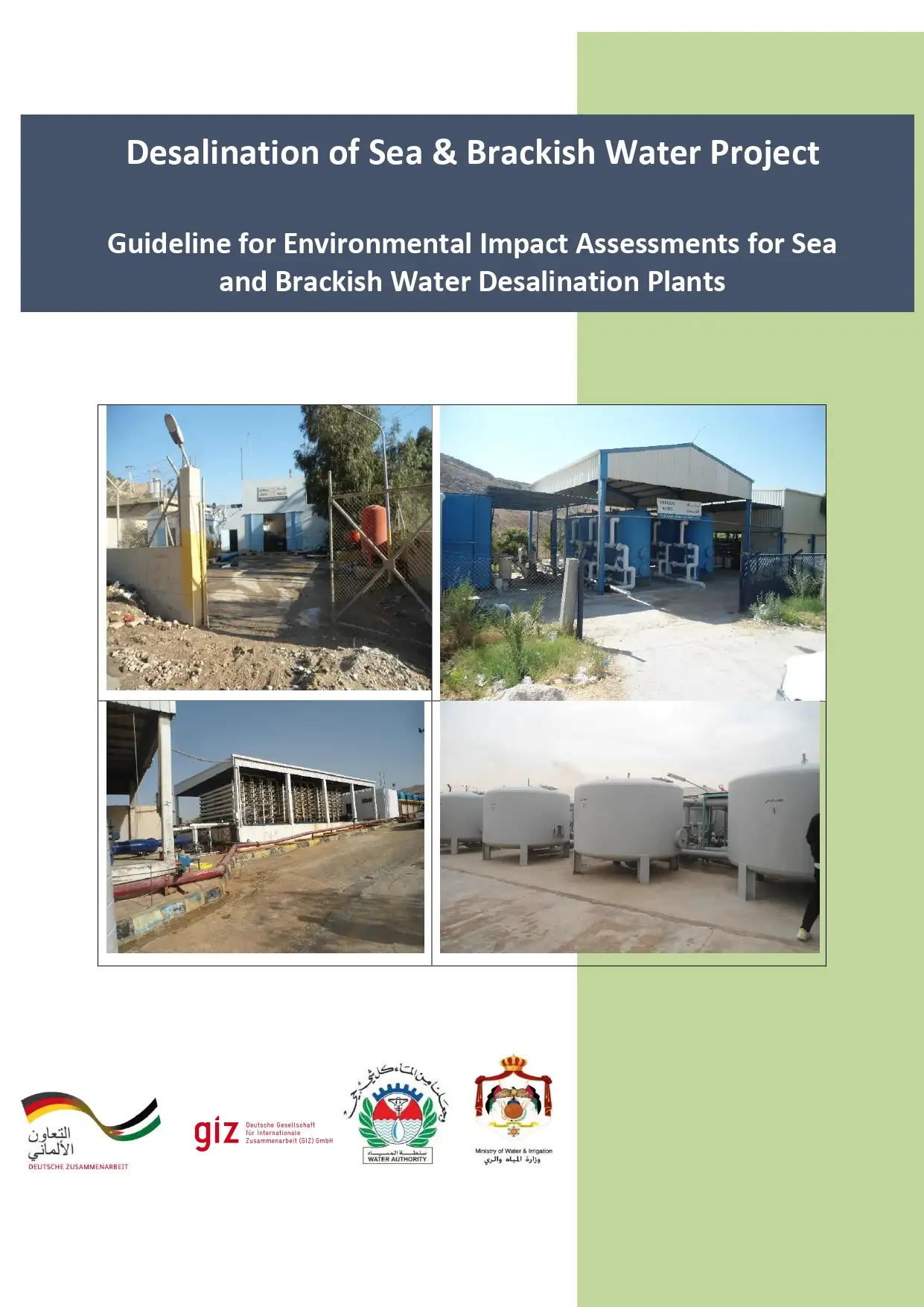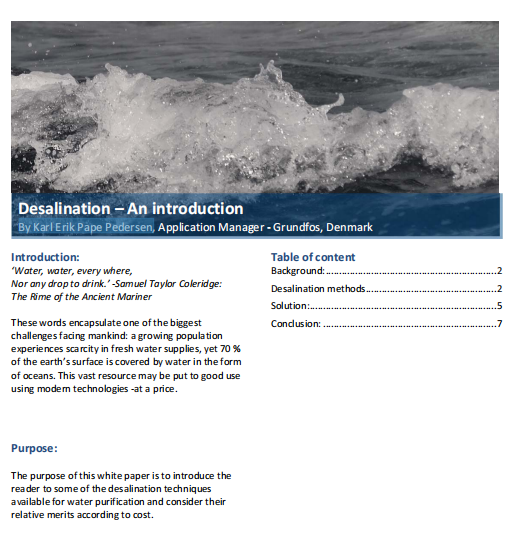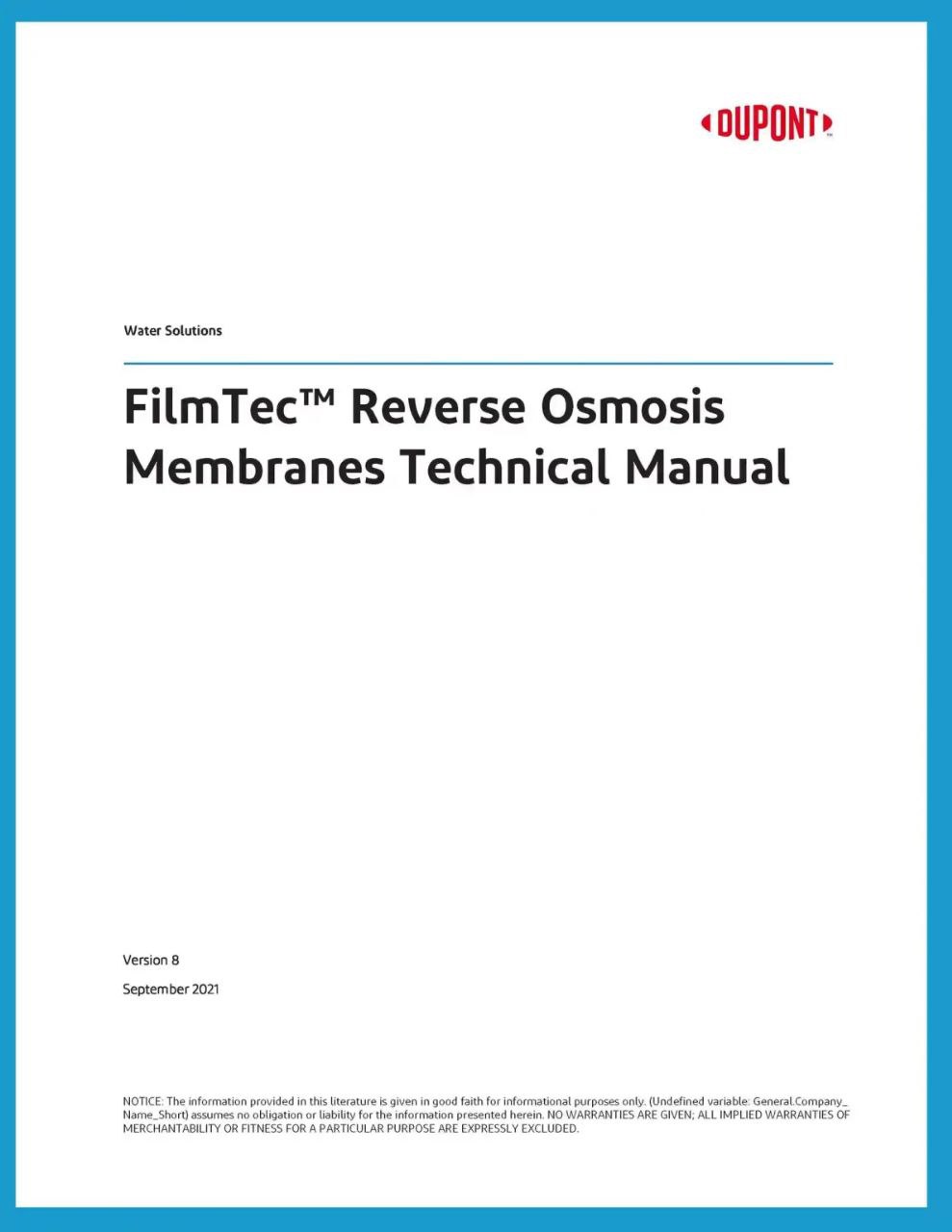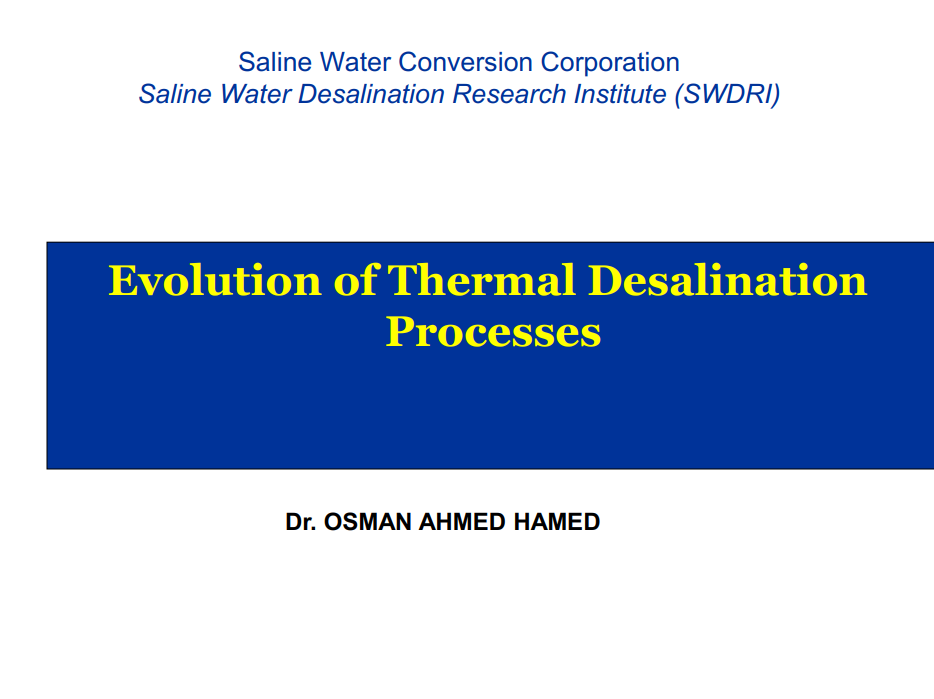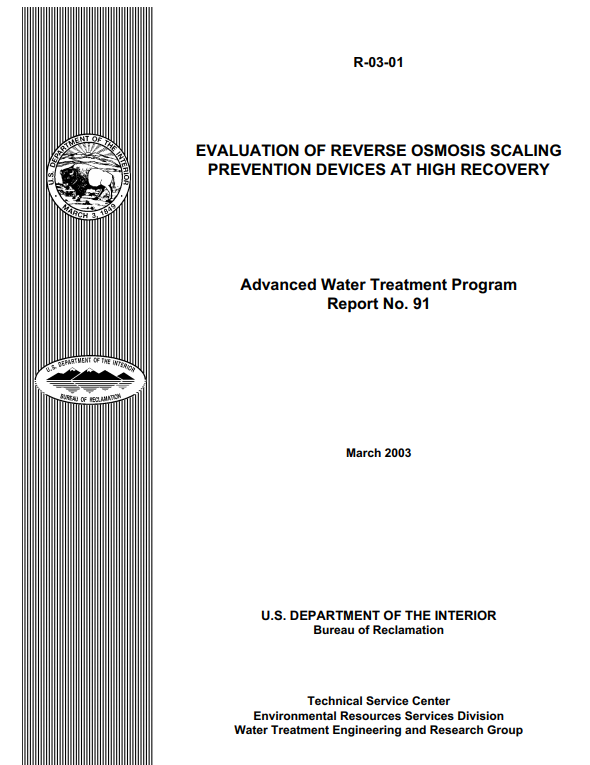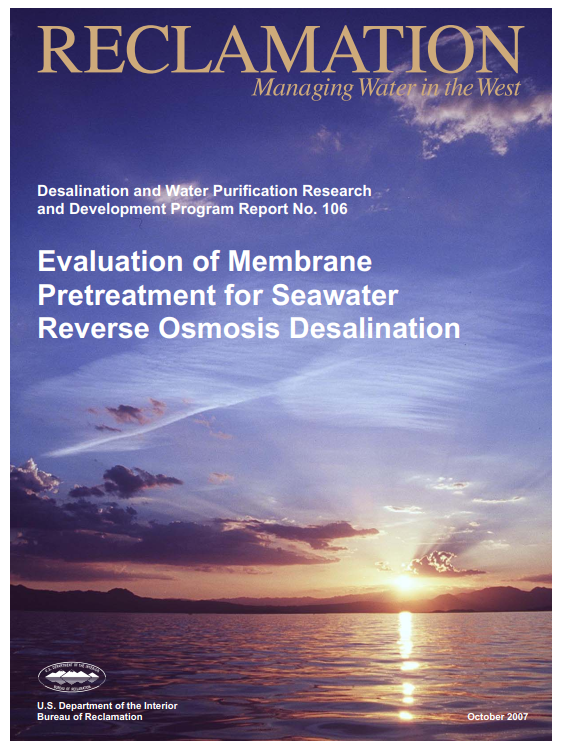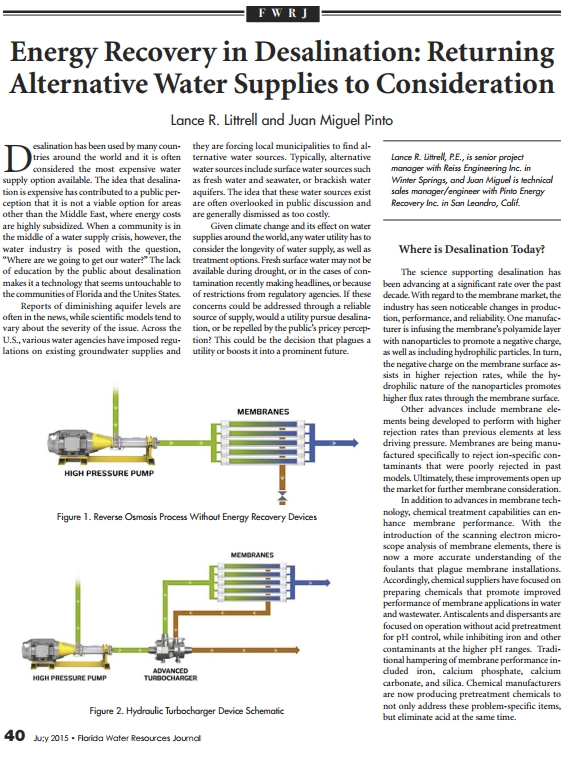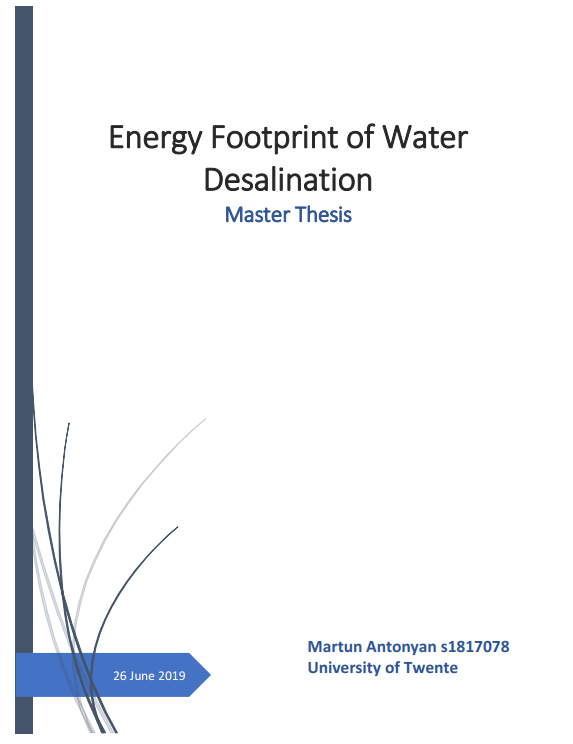Information Source Guide Water Desalination
Abstract:
While the importance of desalination has been increasing steadily over the past decades, views on the merits of desalination among water professionals differ. Some portray desalination as a panacea for much of the world's water woes. Others perceive desalination very negatively because of its alleged high costs, energy intensity and environmental impacts. While none of these extreme positions appears to be justified, it remains even more necessary to gain an objective understanding of the real stakes in desalination in the context of integrated water resources management. The World Bank has undertaken a regional study that aims at improving the understanding of desalination within the Bank and among some of its clients in the Middle East, North Africa and Central Asia. It also tries to clarify the conditions under which desalination can help in reaching the United Nation's Millennium Development Goals (MDGs) for water supply and sanitation. The study, which has been funded by the Bank-Netherlands Water Partnership, includes case studies of Algeria, Cyprus, Jordan, Malta, Tunisia and Uzbekistan. A key conclusion of the study is that desalination alone cannot deliver the promise of improved water supply. The ability to make the best use of desalination is subject to a series of wider water sector related conditions.
Information Source Guide Water Desalination
Abstract:
While the importance of desalination has been increasing steadily over the past decades, views on the merits of desalination among water professionals differ. Some portray desalination as a panacea for much of the world's water woes. Others perceive desalination very negatively because of its alleged high costs, energy intensity and environmental impacts. While none of these extreme positions appears to be justified, it remains even more necessary to gain an objective understanding of the real stakes in desalination in the context of integrated water resources management. The World Bank has undertaken a regional study that aims at improving the understanding of desalination within the Bank and among some of its clients in the Middle East, North Africa and Central Asia. It also tries to clarify the conditions under which desalination can help in reaching the United Nation's Millennium Development Goals (MDGs) for water supply and sanitation. The study, which has been funded by the Bank-Netherlands Water Partnership, includes case studies of Algeria, Cyprus, Jordan, Malta, Tunisia and Uzbekistan. A key conclusion of the study is that desalination alone cannot deliver the promise of improved water supply. The ability to make the best use of desalination is subject to a series of wider water sector related conditions.
Improved Energy Efficiency of Electrodialysis Desalination and Separation: Development of Percolating Network Nanocomposite Ion-Exchange Membranes for High Conductivity
Abstract:
Nanocomposite cation exchange membranes have been fabricated by incorporating sulphonate carbon nanotubes into sulphonate poly(p-phenylene oxide) polymer matrix (0-20 w/w%). The percolating network of carbon nanotubes can advantageously lower the intrinsic resistivity of the nanocomposite membrane while the charged functional moieties intensifies the Donnan exclusion effect, thus sustaining a high perm selectivity. Nanocomposite IEMs exhibit improved conductivity while maintaining perm selectivity. Intrinsic resistivity, inverse of conductivity, decreases 25 to 29 percent, with 20 percent incorporation of sCNT. Enhancement in conductivity is more pronounced for membranes with lower swelling degree. The nanocomposite fabrication strategy can advance the perm selectivity-conductivity tradeoff to obtain IEMs with improved performance. The electro dialysis desalination of brackish water to drinking water standards (1,000 ppm TDS) has been demonstrated with the fabricated nanocomposite membranes. Projected energy savings of about 13.3 to 15.8 percent for brackish water desalination is achievable with nanocomposite membranes. This study demonstrates the rational use of nanomaterials as a promising platform to advance the conductivity-perm selectivity trade-off governing conventional IEMs.
Improved Energy Efficiency of Electrodialysis Desalination and Separation: Development of Percolating Network Nanocomposite Ion-Exchange Membranes for High Conductivity
Abstract:
Nanocomposite cation exchange membranes have been fabricated by incorporating sulphonate carbon nanotubes into sulphonate poly(p-phenylene oxide) polymer matrix (0-20 w/w%). The percolating network of carbon nanotubes can advantageously lower the intrinsic resistivity of the nanocomposite membrane while the charged functional moieties intensifies the Donnan exclusion effect, thus sustaining a high perm selectivity. Nanocomposite IEMs exhibit improved conductivity while maintaining perm selectivity. Intrinsic resistivity, inverse of conductivity, decreases 25 to 29 percent, with 20 percent incorporation of sCNT. Enhancement in conductivity is more pronounced for membranes with lower swelling degree. The nanocomposite fabrication strategy can advance the perm selectivity-conductivity tradeoff to obtain IEMs with improved performance. The electro dialysis desalination of brackish water to drinking water standards (1,000 ppm TDS) has been demonstrated with the fabricated nanocomposite membranes. Projected energy savings of about 13.3 to 15.8 percent for brackish water desalination is achievable with nanocomposite membranes. This study demonstrates the rational use of nanomaterials as a promising platform to advance the conductivity-perm selectivity trade-off governing conventional IEMs.
Implementation of the National Desalination and Water Purification Technology Roadmap: Structuring and Directing the Development of Water Supply Solutions
INTRODUCTION:
In the United States, economic growth increasingly requires that greater volumes of freshwater be made available for new users, yet supplies of freshwater are already allocated to existing users. Currently, water for new users is made available through re-allocation of existing water supplies—for example, by cities purchasing agricultural water rights. Water may also be made available through conservation efforts and, in some locales, through the development of “new” water from non-traditional sources such as the oceans, deep aquifer brackish groundwater, and water reuse. Developing “new” water from non-traditional sources relies primarily on membrane filtration (e.g., reverse osmosis) and to a lesser extent distillation. Both are technology-intensive processes whose future depends on the development of, respectively, better membranes and more efficient heat transfer approaches. Membrane filtration in particular carries with it weighty pre- and post-treatment concerns: How to prevent the formation of filter-clogging inorganic and biologic scales? How to dispose of residual concentrated brines? How to chemically stabilize the water that is produced?
Water development in the 20th century largely involved the physical collection and transfer of freshwater by dams and aqueducts. Because of tightening supplies and public resistance to further dam building, water development in the 21st century will increasingly rely on creating or reclaiming water from non traditional sources by membrane filtration and other desalination processes. Since the latter are tied so strongly to technology, the absolute volume of new water produced in the United States in the 21st century will likely reflect the extent of new research and development investment in desalination. This has happened before. In the 1950s and 1960s, the U.S. government invested a total of roughly $900 million (in 1985 dollars) in desalination research conducted through the Office of Saline Water in the Department of the Interior. Reverse osmosis (RO) desalination is one of the notable inventions that resulted from this federal investment: RO is presently a $2 billion per year global market, and the technology is used to produce six billion gallons of water per day.
Increasing the availability of new water will likely require a renewed national commitment to
desalination research and development.
Implementation of the National Desalination and Water Purification Technology Roadmap: Structuring and Directing the Development of Water Supply Solutions
INTRODUCTION:
In the United States, economic growth increasingly requires that greater volumes of freshwater be made available for new users, yet supplies of freshwater are already allocated to existing users. Currently, water for new users is made available through re-allocation of existing water supplies—for example, by cities purchasing agricultural water rights. Water may also be made available through conservation efforts and, in some locales, through the development of “new” water from non-traditional sources such as the oceans, deep aquifer brackish groundwater, and water reuse. Developing “new” water from non-traditional sources relies primarily on membrane filtration (e.g., reverse osmosis) and to a lesser extent distillation. Both are technology-intensive processes whose future depends on the development of, respectively, better membranes and more efficient heat transfer approaches. Membrane filtration in particular carries with it weighty pre- and post-treatment concerns: How to prevent the formation of filter-clogging inorganic and biologic scales? How to dispose of residual concentrated brines? How to chemically stabilize the water that is produced?
Water development in the 20th century largely involved the physical collection and transfer of freshwater by dams and aqueducts. Because of tightening supplies and public resistance to further dam building, water development in the 21st century will increasingly rely on creating or reclaiming water from non traditional sources by membrane filtration and other desalination processes. Since the latter are tied so strongly to technology, the absolute volume of new water produced in the United States in the 21st century will likely reflect the extent of new research and development investment in desalination. This has happened before. In the 1950s and 1960s, the U.S. government invested a total of roughly $900 million (in 1985 dollars) in desalination research conducted through the Office of Saline Water in the Department of the Interior. Reverse osmosis (RO) desalination is one of the notable inventions that resulted from this federal investment: RO is presently a $2 billion per year global market, and the technology is used to produce six billion gallons of water per day.
Increasing the availability of new water will likely require a renewed national commitment to
desalination research and development.
Impact of Magnetic Fields on Reverse Osmosis Separation: A Laboratory Study
ABSTRACT:
This research investigated the effects of electromagnetic fields on salt and water transport in reverse osmosis (RO) membranes. Two experimental apparatus were considered—the PowerSurvivor-35 from PUR and a classic lab scale RO system. For both systems, the electromagnetic field was generated by a solenoid placed around the pressure vessel. The field intensity was 680 Gs, and the field frequency was 40 hertz (Hz) and 300 Hz. The studied salts were LiCl, NaCl, KCl, MgCl2, and CaCl2 at concentrations of 0.02 M, 0.05 M and 0.1 M. The preferential sorption-capillary flow model was used to calculate the transport parameters in the membrane.
Impact of Magnetic Fields on Reverse Osmosis Separation: A Laboratory Study
ABSTRACT:
This research investigated the effects of electromagnetic fields on salt and water transport in reverse osmosis (RO) membranes. Two experimental apparatus were considered—the PowerSurvivor-35 from PUR and a classic lab scale RO system. For both systems, the electromagnetic field was generated by a solenoid placed around the pressure vessel. The field intensity was 680 Gs, and the field frequency was 40 hertz (Hz) and 300 Hz. The studied salts were LiCl, NaCl, KCl, MgCl2, and CaCl2 at concentrations of 0.02 M, 0.05 M and 0.1 M. The preferential sorption-capillary flow model was used to calculate the transport parameters in the membrane.
Hybrid NF-RO Sodium Chloride Removal Process Pilot Study
Abstract:
Concentrate disposal is a major cost for desalting operations, particularly for inland sites. For many water recycling applications, only partial desalting is needed, with sodium chloride the most common target for removal. A process to preferentially remove sodium chloride could result in significant savings for concentrate treatment and disposal. A pilot study was conducted to demonstrate the viability of one such approach. This pilot study examined the salt passage characteristics of several nanofiltration (NF) membranes to segregate sodium chloride from other dissolved ions. The pilot study testing unit used a two-pass system, combining an NF pass with a second reverse osmosis (RO) pass. In this approach, unlike typical two-pass systems, the concentrate from the first NF pass is blended with the permeate from the second RO pass. Since the NF effectively retains total organic carbon (TOC), chemicals of emerging concern (CECs), and any pathogens, these contaminants are blended into the product water. Thus, further treatment may be necessary for potable reuse applications. The pilot study consisted of a scalable two-pass NF-RO membrane system operated in parallel with full scale RO units. Water quality, power consumption, and chemical consumption were tracked for 6 months at varying system conditions. Findings indicate that sodium chloride can be preferentially removed from the reclaimed water, chemical and power consumption can be reduced when operated at system recoveries comparable to typical RO systems, and much higher recoveries are achievable with modest increases in power and chemical usage.
Hybrid NF-RO Sodium Chloride Removal Process Pilot Study
Abstract:
Concentrate disposal is a major cost for desalting operations, particularly for inland sites. For many water recycling applications, only partial desalting is needed, with sodium chloride the most common target for removal. A process to preferentially remove sodium chloride could result in significant savings for concentrate treatment and disposal. A pilot study was conducted to demonstrate the viability of one such approach. This pilot study examined the salt passage characteristics of several nanofiltration (NF) membranes to segregate sodium chloride from other dissolved ions. The pilot study testing unit used a two-pass system, combining an NF pass with a second reverse osmosis (RO) pass. In this approach, unlike typical two-pass systems, the concentrate from the first NF pass is blended with the permeate from the second RO pass. Since the NF effectively retains total organic carbon (TOC), chemicals of emerging concern (CECs), and any pathogens, these contaminants are blended into the product water. Thus, further treatment may be necessary for potable reuse applications. The pilot study consisted of a scalable two-pass NF-RO membrane system operated in parallel with full scale RO units. Water quality, power consumption, and chemical consumption were tracked for 6 months at varying system conditions. Findings indicate that sodium chloride can be preferentially removed from the reclaimed water, chemical and power consumption can be reduced when operated at system recoveries comparable to typical RO systems, and much higher recoveries are achievable with modest increases in power and chemical usage.
Guidelines for the Use of Stainless Steel in the Water and Desalination Industries
This study was jointly funded by the Water Research Foundation (WRF), Eastern Municipal Water District (EMWD), and the U.S. Bureau of Reclamation (Reclamation). WRF, EMWD, and Reclamation assume no responsibility for the content of the research study reported in this publication or for the opinions or statements of fact expressed in the report. The mention of trade names for commercial products does not represent or imply the approval or endorsement of WRF, EMWD, or Reclamation. This report is presented solely for informational purposes.
Guidelines for the Use of Stainless Steel in the Water and Desalination Industries
This study was jointly funded by the Water Research Foundation (WRF), Eastern Municipal Water District (EMWD), and the U.S. Bureau of Reclamation (Reclamation). WRF, EMWD, and Reclamation assume no responsibility for the content of the research study reported in this publication or for the opinions or statements of fact expressed in the report. The mention of trade names for commercial products does not represent or imply the approval or endorsement of WRF, EMWD, or Reclamation. This report is presented solely for informational purposes.
Guidelines For The Regulation Of Desalination
Introduction
This report aims to develop guidelines for legislation addressing drinking water quality and environmental protection aspects related to desalination driven by renewable energy (RE‐ Desalination). At the same time ways to remove some of the barriers RE‐Desalination is facing are recommended in order to assist a deployment of these facilities for an improved access to safe and sustainable drinking water in regions of water scarcity.
The report has been developed within the ProDes project which is promoting the market development of desalination driven by renewable energies in Southern Europe. ProDes is co‐funded by the European Commission through the Intelligent Energy Programme and has been supporting RE‐Desalination through various activities like training for professionals and students, seminars and technical publications. Extensive information about ProDes, the partners and the results is published on the project website: www.prodes‐project.org.
The report includes an overview of currently existing guidance on desalination driven by renewable energies followed by an analysis of health, environmental and administrative aspects critical for the development of guidelines. General recommendations of elements to be included in guidelines are developed from a literature analysis. To what extent these qualify for application in various circumstances should be tested in additional country‐specific studies
Guidelines For The Regulation Of Desalination
Introduction
This report aims to develop guidelines for legislation addressing drinking water quality and environmental protection aspects related to desalination driven by renewable energy (RE‐ Desalination). At the same time ways to remove some of the barriers RE‐Desalination is facing are recommended in order to assist a deployment of these facilities for an improved access to safe and sustainable drinking water in regions of water scarcity.
The report has been developed within the ProDes project which is promoting the market development of desalination driven by renewable energies in Southern Europe. ProDes is co‐funded by the European Commission through the Intelligent Energy Programme and has been supporting RE‐Desalination through various activities like training for professionals and students, seminars and technical publications. Extensive information about ProDes, the partners and the results is published on the project website: www.prodes‐project.org.
The report includes an overview of currently existing guidance on desalination driven by renewable energies followed by an analysis of health, environmental and administrative aspects critical for the development of guidelines. General recommendations of elements to be included in guidelines are developed from a literature analysis. To what extent these qualify for application in various circumstances should be tested in additional country‐specific studies
Desalination of Sea & Brackish Water Project
Introduction:
Desalination projects require an Environmental and Social Impact Assessment (ESIA) study to determine the potential impacts a project can have on the environment. The “ESIA” considers all environmental pathways. It evaluates the potential impacts on air, land, and marine environments and proposes mitigation measures to reduce environmental impacts. The potential impacts of desalination plants are different from the environmental impacts of other facilities. In particular, the brine discharge from desalination plants can have huge impacts. Therefore, it is proposed by this document to follow a dedicated routine in the ESIA process for brackish and seawater desalination plants. An “ESIA” needs to cover the following stages of a project which are: the construction; the operation, and the decommissioning stages. During the construction stage, the construction process can be time-consuming, inconvenient, loud, destructive, and disruptive to the environment. It is ideal to have as little impact from the construction as necessary. If used water resources, connections to services, and water infrastructure are near the proposed plant site, then there will be fewer constructional interventions required and thus less potential environmental damages would occur. When construction begins, the party responsible for follow-up on the ESIA needs to monitor according to the Environmental Management Plan issues identified in the ESIA so that the agreed plan is implemented and followed. For the operation stage, the “ESIA” report discusses the chosen desalination process, the emissions process will generate, the implications the facility will have on the environment, the considerations to be made about the energy supply, the benefits the facility will have on the local community from a socio-economic perspective, and the proposed mitigation measures to reduce problems associated with the facility. It is even more important to monitor all aspects addressed in the ESIA’s Environmental Management Plans (EMP) during the operational stage to ensure consistent compliance with agreed permittable environmental impacts
Desalination of Sea & Brackish Water Project
Introduction:
Desalination projects require an Environmental and Social Impact Assessment (ESIA) study to determine the potential impacts a project can have on the environment. The “ESIA” considers all environmental pathways. It evaluates the potential impacts on air, land, and marine environments and proposes mitigation measures to reduce environmental impacts. The potential impacts of desalination plants are different from the environmental impacts of other facilities. In particular, the brine discharge from desalination plants can have huge impacts. Therefore, it is proposed by this document to follow a dedicated routine in the ESIA process for brackish and seawater desalination plants. An “ESIA” needs to cover the following stages of a project which are: the construction; the operation, and the decommissioning stages. During the construction stage, the construction process can be time-consuming, inconvenient, loud, destructive, and disruptive to the environment. It is ideal to have as little impact from the construction as necessary. If used water resources, connections to services, and water infrastructure are near the proposed plant site, then there will be fewer constructional interventions required and thus less potential environmental damages would occur. When construction begins, the party responsible for follow-up on the ESIA needs to monitor according to the Environmental Management Plan issues identified in the ESIA so that the agreed plan is implemented and followed. For the operation stage, the “ESIA” report discusses the chosen desalination process, the emissions process will generate, the implications the facility will have on the environment, the considerations to be made about the energy supply, the benefits the facility will have on the local community from a socio-economic perspective, and the proposed mitigation measures to reduce problems associated with the facility. It is even more important to monitor all aspects addressed in the ESIA’s Environmental Management Plans (EMP) during the operational stage to ensure consistent compliance with agreed permittable environmental impacts
Desalination – An introduction
Introduction:
Water, water, every where, Nor any drop to drink.’ ‐Samuel Taylor Coleridge: The Rime of the Ancient Mariner These words encapsulate one of the biggest challenges facing mankind: a growing population experiences scarcity in fresh water supplies, yet 70 % of the earth’s surface is covered by water in the form of oceans. This vast resource may be put to good use using modern technologies ‐at a price.
Desalination – An introduction
Introduction:
Water, water, every where, Nor any drop to drink.’ ‐Samuel Taylor Coleridge: The Rime of the Ancient Mariner These words encapsulate one of the biggest challenges facing mankind: a growing population experiences scarcity in fresh water supplies, yet 70 % of the earth’s surface is covered by water in the form of oceans. This vast resource may be put to good use using modern technologies ‐at a price.
Forward Osmosis
Abstract:
Fresh, potable water is an essential human need and thus looming water shortages threaten the world’s peace and prosperity. Waste water, brackish water, and seawater have great potential to fill the coming requirements. Unfortunately, the ability to exploit these resources is currently limited in many parts of the world by both the cost of the energy and the investment in equipment required for purification/desalination. Current research suggests that forward osmosis is a novel, low-energy, and thus low cost method of desalination and developing practical draw solutions can improve the efficiency of this process.
To address these limitations, this study focuses on forward osmosis technology, its effective operational conditions chosen wisely based on the membrane to be used and the streams to be treated and providing a feasible economic estimation
Forward Osmosis
Abstract:
Fresh, potable water is an essential human need and thus looming water shortages threaten the world’s peace and prosperity. Waste water, brackish water, and seawater have great potential to fill the coming requirements. Unfortunately, the ability to exploit these resources is currently limited in many parts of the world by both the cost of the energy and the investment in equipment required for purification/desalination. Current research suggests that forward osmosis is a novel, low-energy, and thus low cost method of desalination and developing practical draw solutions can improve the efficiency of this process.
To address these limitations, this study focuses on forward osmosis technology, its effective operational conditions chosen wisely based on the membrane to be used and the streams to be treated and providing a feasible economic estimation
Reverse Osmosis Membranes Technical Manual
Introduction:
To increase the efficiency and life of reverse osmosis and nanofiltration (RO/NF) systems, effective pretreatment of the feedwater is required. Selection of the proper pretreatment will maximize efficiency and membrane life by minimizing:
- Fouling
- Scaling
- Membrane degradation
Reverse Osmosis Membranes Technical Manual
Introduction:
To increase the efficiency and life of reverse osmosis and nanofiltration (RO/NF) systems, effective pretreatment of the feedwater is required. Selection of the proper pretreatment will maximize efficiency and membrane life by minimizing:
- Fouling
- Scaling
- Membrane degradation
Evaluation Of Reverse Osmosis Scaling Prevention Devices At High Recovery
Abstract:
This study evaluated the effectiveness of a magnetic device (MD) and a high voltage capacitance device (HVC) as possible alternatives to the dosing of chemical antiscalants for preventing scaling during reverse osmosis (RO) operation at high product water recovery. The tests were conducted on feed water to the Bureau of Reclamation’s 72-MGD Yuma Desalting Plant located in Yuma AZ. High overall recoveries of greater than 90 percent were achieved by operating a two-stage 4-gal/min RO pilot unit (membrane unit 1 [MU1]) on the concentrate from a 200-gal/min RO unit operating at a water recovery of 70-percent. In these tests, neither the MD nor the HVC were effective in preventing calcium sulfate scaling at 91-percent water recovery. In contrast, the addition of 2 mg/L of sodium hexametaphosphate (SHMP) to MU1 feed water was successful in avoiding scale at recoveries of 93 percent. Dosing of SHMP (or other chemical antiscalant) remains the recommended method for achieving high recovery operation without scaling at the Yuma Desalting Plant.
Evaluation Of Reverse Osmosis Scaling Prevention Devices At High Recovery
Abstract:
This study evaluated the effectiveness of a magnetic device (MD) and a high voltage capacitance device (HVC) as possible alternatives to the dosing of chemical antiscalants for preventing scaling during reverse osmosis (RO) operation at high product water recovery. The tests were conducted on feed water to the Bureau of Reclamation’s 72-MGD Yuma Desalting Plant located in Yuma AZ. High overall recoveries of greater than 90 percent were achieved by operating a two-stage 4-gal/min RO pilot unit (membrane unit 1 [MU1]) on the concentrate from a 200-gal/min RO unit operating at a water recovery of 70-percent. In these tests, neither the MD nor the HVC were effective in preventing calcium sulfate scaling at 91-percent water recovery. In contrast, the addition of 2 mg/L of sodium hexametaphosphate (SHMP) to MU1 feed water was successful in avoiding scale at recoveries of 93 percent. Dosing of SHMP (or other chemical antiscalant) remains the recommended method for achieving high recovery operation without scaling at the Yuma Desalting Plant.
Evaluation of Membrane Pretreatment for Seawater Reverse Osmosis Desalination
Abstract:
This project was undertaken to better understand the technical and cost implications of the use of membrane filtration as pretreatment for seawater reverse osmosis (RO). The pilot study was conducted using raw feed water from the Corpus Christi Bay in Texas, at the San Patricio Municipal Water District facility. The pilot study consisted of a side-by-side comparison of membrane filtration and conventional filtration, both followed by separate RO pilot systems, testing over an approximate 1-year period. The results indicate that membrane filtration produced far superior water quality for pretreatment, measured by reduced turbidity and by the silt density index (SDI). The resulting impact on the RO performance was a significantly lower RO cleaning frequency. The economic evaluation indicates that on a life-cycle cost analysis, the total water cost (TWC) for a plant using membrane filtration is 4-8% less than a plant using media filtration.
Evaluation of Membrane Pretreatment for Seawater Reverse Osmosis Desalination
Abstract:
This project was undertaken to better understand the technical and cost implications of the use of membrane filtration as pretreatment for seawater reverse osmosis (RO). The pilot study was conducted using raw feed water from the Corpus Christi Bay in Texas, at the San Patricio Municipal Water District facility. The pilot study consisted of a side-by-side comparison of membrane filtration and conventional filtration, both followed by separate RO pilot systems, testing over an approximate 1-year period. The results indicate that membrane filtration produced far superior water quality for pretreatment, measured by reduced turbidity and by the silt density index (SDI). The resulting impact on the RO performance was a significantly lower RO cleaning frequency. The economic evaluation indicates that on a life-cycle cost analysis, the total water cost (TWC) for a plant using membrane filtration is 4-8% less than a plant using media filtration.
Energy Recovery in Desalination: Returning Alternative Water Supplies to Consideration
Abstract:
Desalination has been used by many countries around the world and it is often considered the most expensive water supply option available. The idea that desalination is expensive has contributed to a public perception that it is not a viable option for areas other than the Middle East, where energy costs are highly subsidized. When a community is in the middle of a water supply crisis, however, the water industry is posed with the question, “Where are we going to get our water?” The lack of education by the public about desalination makes it a technology that seems untouchable to the communities of Florida and the Unites States. Reports of diminishing aquifer levels are often in the news, while scientific models tend to vary about the severity of the issue. Across the U.S., various water agencies have imposed regulations on existing groundwater supplies and they are forcing local municipalities to find alternative water sources. Typically, alternative water sources include surface water sources such as fresh water and seawater, or brackish water aquifers. The idea that these water sources exist are often overlooked in public discussion and are generally dismissed as too costly. Given climate change and its effect on water supplies around the world, any water utility has to consider the longevity of water supply, as well as treatment options.
Energy Recovery in Desalination: Returning Alternative Water Supplies to Consideration
Abstract:
Desalination has been used by many countries around the world and it is often considered the most expensive water supply option available. The idea that desalination is expensive has contributed to a public perception that it is not a viable option for areas other than the Middle East, where energy costs are highly subsidized. When a community is in the middle of a water supply crisis, however, the water industry is posed with the question, “Where are we going to get our water?” The lack of education by the public about desalination makes it a technology that seems untouchable to the communities of Florida and the Unites States. Reports of diminishing aquifer levels are often in the news, while scientific models tend to vary about the severity of the issue. Across the U.S., various water agencies have imposed regulations on existing groundwater supplies and they are forcing local municipalities to find alternative water sources. Typically, alternative water sources include surface water sources such as fresh water and seawater, or brackish water aquifers. The idea that these water sources exist are often overlooked in public discussion and are generally dismissed as too costly. Given climate change and its effect on water supplies around the world, any water utility has to consider the longevity of water supply, as well as treatment options.
Energy Footprint Of Water Desalination
Abstract:
Demand for the freshwater is growing due to the growth of world population that entails growing demand of freshwater for agricultural and industrial purposes. However, the fresh water availability on Earth is limited and many countries face severe water shortages. Water desalination could be a possible solution for this problem. Among the variety of existing water desalination technologies, three are particularly promising, these are: reverse osmosis (RO), multi stage flash (MSF), multi effect distillation (MED). Energy consumption of desalination processes are determined by factors like capacity of desalination plant (small, medium, large), the energy source (electricity vs thermal), type of feed water (brackish (BW) vs seawater (SW)), desalination method (thermal vs membrane), use of renewable energy sources (solar, wind, geothermal), and necessity of feed pretreatment (mechanical and/or chemical). In this paper, I compare the total energy consumption of different methods considering each influential factor and categorizing the existing desalination techniques. Results suggest that the membrane-based technologies are the least energy intensive. 8W RO of medium and large scales require 1.9 kW h/m3. Then comes SW RO of medium size and SW RO of large scale with 4.3 and 4.4 kW h/m3 energy consumption. The thermal desalination techniques, primarily MSF and MED have much higher energy footprint, than the membrane ones. They consume 17.1 and 11.9 kW h/m3 respectively, however, thermal technologies are more efficient for desalination of very salty waters. Nevertheless, membrane-based desalination methods due to their less energy-intensive nature and small footprint became more popular than the thermal technologies and substantial efforts have been observed in integrating RO with renewable energy sources, mainly wind and solar. Energy footprint of this type of desalination techniques is in between the membrane and thermal routes. The energy consumption of renewable powered desalination plants ranges from 1.5 to 21.1 kW h/m3. Their main drawback is small capacity, which makes them non-competitive with conventionally powered plants. We could say that globally humanity spent 7 kW h energy for desalination of 1 m3 of water. For the most of developed countries desalination has large contribution to the total fresh water supply. However, the conventional energy sources are forecasted to be depleted in the near future. The main question is: can desalination satisfy the total fresh water demand at least in the coastal regions within 100 kilometers, where presently about 40% of the world's population live? And should we consider desalination only for municipal purposes or for industrial and agricultural purposes as well? Rough estimation was done regarding the land requirement for solar panels to be able to supply the energy demand from SW RO desalination that is based on solar energy. As a model for such a study I decided to choose a city with 1 million inhabitants located in the territory of Saudi Arabia. To supply 1 million people with fresh water, desalination plant should have 270 000 m3/day capacity for municipal purposes and 1 470 000 m3/day capacity for industrial and agricultural purposes as well. Desalinating freshwater to meet only the municipal purposes a 5.18 km2 of land is required for building a solar park or almost 700 modern soccer fields and for the industrial and agricultural purposes the land requirement increases to — 28.22 km2, which is 3804 soccer fields. The results change, if we change the location of desalination plant, owing mainly to the difference in the amount of radiance that earth surface receives. The sensitivity analysis of a land requirement dependency on radiance was further calculated.
Energy Footprint Of Water Desalination
Abstract:
Demand for the freshwater is growing due to the growth of world population that entails growing demand of freshwater for agricultural and industrial purposes. However, the fresh water availability on Earth is limited and many countries face severe water shortages. Water desalination could be a possible solution for this problem. Among the variety of existing water desalination technologies, three are particularly promising, these are: reverse osmosis (RO), multi stage flash (MSF), multi effect distillation (MED). Energy consumption of desalination processes are determined by factors like capacity of desalination plant (small, medium, large), the energy source (electricity vs thermal), type of feed water (brackish (BW) vs seawater (SW)), desalination method (thermal vs membrane), use of renewable energy sources (solar, wind, geothermal), and necessity of feed pretreatment (mechanical and/or chemical). In this paper, I compare the total energy consumption of different methods considering each influential factor and categorizing the existing desalination techniques. Results suggest that the membrane-based technologies are the least energy intensive. 8W RO of medium and large scales require 1.9 kW h/m3. Then comes SW RO of medium size and SW RO of large scale with 4.3 and 4.4 kW h/m3 energy consumption. The thermal desalination techniques, primarily MSF and MED have much higher energy footprint, than the membrane ones. They consume 17.1 and 11.9 kW h/m3 respectively, however, thermal technologies are more efficient for desalination of very salty waters. Nevertheless, membrane-based desalination methods due to their less energy-intensive nature and small footprint became more popular than the thermal technologies and substantial efforts have been observed in integrating RO with renewable energy sources, mainly wind and solar. Energy footprint of this type of desalination techniques is in between the membrane and thermal routes. The energy consumption of renewable powered desalination plants ranges from 1.5 to 21.1 kW h/m3. Their main drawback is small capacity, which makes them non-competitive with conventionally powered plants. We could say that globally humanity spent 7 kW h energy for desalination of 1 m3 of water. For the most of developed countries desalination has large contribution to the total fresh water supply. However, the conventional energy sources are forecasted to be depleted in the near future. The main question is: can desalination satisfy the total fresh water demand at least in the coastal regions within 100 kilometers, where presently about 40% of the world's population live? And should we consider desalination only for municipal purposes or for industrial and agricultural purposes as well? Rough estimation was done regarding the land requirement for solar panels to be able to supply the energy demand from SW RO desalination that is based on solar energy. As a model for such a study I decided to choose a city with 1 million inhabitants located in the territory of Saudi Arabia. To supply 1 million people with fresh water, desalination plant should have 270 000 m3/day capacity for municipal purposes and 1 470 000 m3/day capacity for industrial and agricultural purposes as well. Desalinating freshwater to meet only the municipal purposes a 5.18 km2 of land is required for building a solar park or almost 700 modern soccer fields and for the industrial and agricultural purposes the land requirement increases to — 28.22 km2, which is 3804 soccer fields. The results change, if we change the location of desalination plant, owing mainly to the difference in the amount of radiance that earth surface receives. The sensitivity analysis of a land requirement dependency on radiance was further calculated.



